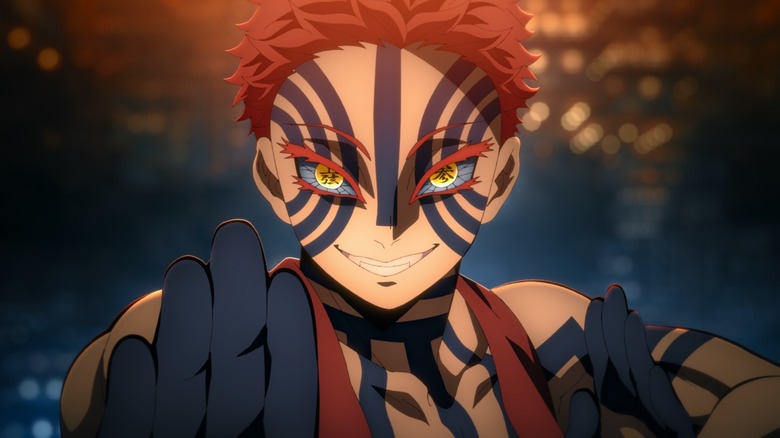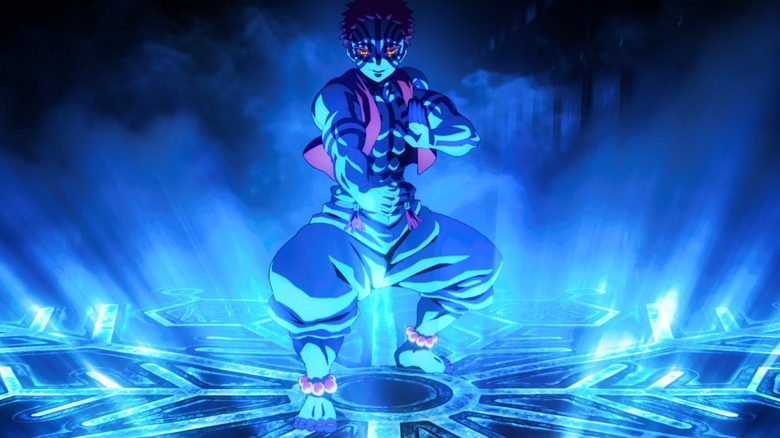Demon Slayer: Infinity Castle Finally Fulfills A Promise About Demons
The following contains spoilers for "Demon Slayer: Infinity Castle."
Anime is having a bit of a demon moment. There are several big and popular shows about demons, like "Jujutsu Kaizen," "Dan Da Dan," and — of course — "Demon Slayer" (not to mention the anime-inspired worldwide hit that is "KPop Demon Slayers"). All of these shows portray the violence and the cruelty of demons while also trying to give them some depth and sympathy, usually explaining how they became the way they are and giving them relatable flaws and traits. The problem with humanizing the murderous demons is that it is tricky to balance giving them enough sympathy that audiences care when they are defeated by the heroes, without having audiences sympathize so much that they forgive the demons' multiple atrocities.
This is a big part of "Demon Slayer," too. Based on the manga of the same name by Koyoharu Gotouge, the show follows Tanjiro Kamado, a young boy who joins a legion of demon-killing soldiers in order to find a way to reverse his sister's condition (she was turned into a demon) and avenge their dead family.
Tanjiro has an unusual amount of empathy for the demons compared to his comrades, going as far as to cry whenever he kills a demon by chopping off their heads. The anime constantly tries to make the audience somewhat sympathetic toward the man-eating monsters by giving each demon a tragic backstory. However, as sad as these origin stories can be in isolation, "Demon Slayer" keeps failing at actually justifying or even connecting the sad backstories with the actions of the demons after they start murdering people. It doesn't matter how tragic a character's life used to be before turning into a demon; they still became murderous monsters that caused untold pain to others.
That changes in "Demon Slayer: Infinity Castle," the first of three theatrical feature films that will serve as the end of the "Demon Slayer" story. "Infinity Castle" gives Akaza (the demon hated by fans for killing beloved character Rengoku) the most tragic backstory in the franchise yet — a backstory that finds the right balance between sympathy and accountability.
The best backstory Demon Slayer has done
We first meet Akaza back in "Mugen Train," which serves as the first movie and technically the second season of "Demon Slayer." Akaza is one of the Twelve Kizuki, the highest-ranked demons serving the demon king Muzan. He kills Hashira Kyojuro Rengoku, one of the strongest members of the Demon Slayer Corps, and escapes before Tanjiro can avenge him.
In "Infinity Castle," we get a rematch between Tanjiro and Akaza. It's a thrilling fight, with spectacular animation and plenty of power-ups and reveals that pay off a story that started back in 2020. Then we learn Akaza's story, going back several centuries to when he grew up as a poor boy forced into a life of crime to fund his father's medication. Unfortunately, after being caught for stealing, Akaza's father committed suicide to escape the shame. Resentful, angry, and very prone to violence, Akaza eventually found inner peace after joining a martial arts dojo and falling in love with the sensei's daughter. But tragedy struck once more when a rival dojo's members murdered the sensei and her daughter while Akaza was away.
Akaza, who had hated life since he was a little boy and didn't think he deserved to live, decided to embrace his hatred and become a demon so that no one could ever be able to hurt him. It's hard not to sympathize with him, and to understand why he'd be so determined to convert humans he considered to be strong into demons. But the flashback does not at any point excuse the hundreds of people Akaza slaughtered. Throughout the fight, Akaza sees visions of the spirits of his loved ones, and they are all disappointed in what he has become and what he's done. That's what makes Akaza's the best backstory in "Demon Slayer," and the one that fulfills the franchise's promise of making the demons sympathetic.

